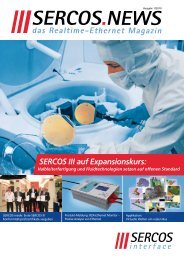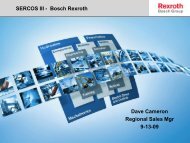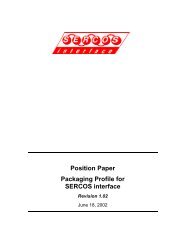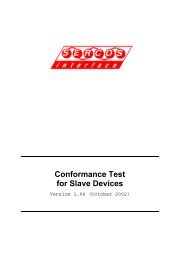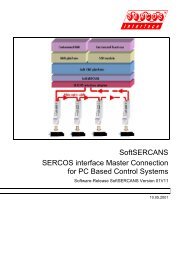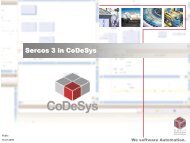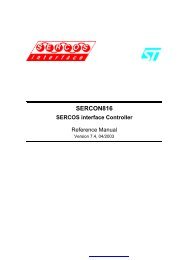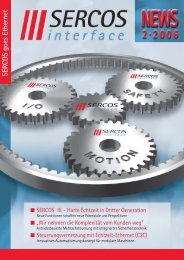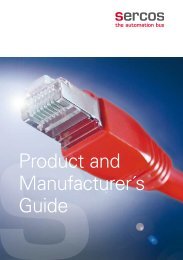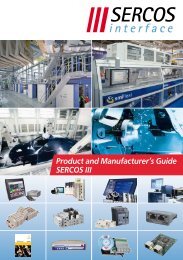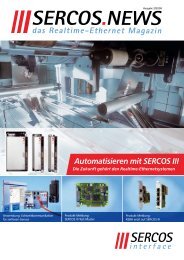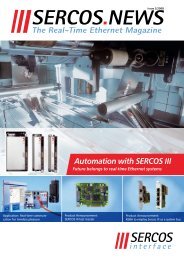SERCOS News - Issue 1 - 2008
SERCOS News - Issue 1 - 2008
SERCOS News - Issue 1 - 2008
You also want an ePaper? Increase the reach of your titles
YUMPU automatically turns print PDFs into web optimized ePapers that Google loves.
4 Sercos-Inside<br />
The Real-Time Ethernet Magazine<br />
Block I/O - easy integration of I/O signals<br />
in <strong>SERCOS</strong> III<br />
mum cycle times of only 31.25 µs (the<br />
blink of an eye takes approx. 330,000<br />
µs), the fast transfer of the information<br />
is guaranteed. Also, the architecture<br />
enables direct communication between<br />
the executing units (slaves) so as to keep<br />
reaction times down to a minimum. To<br />
optimise the network, <strong>SERCOS</strong> III does<br />
not require expensive additional network<br />
components, such as switches or<br />
hubs. The integrated network functions<br />
ensure that TCP/IP packets can also be<br />
transmitted next to the real-time data.<br />
The reliability is increased by a robust design,<br />
a ring structure of the lines against<br />
the consequences of a cable break, as<br />
well as the secured data transmission<br />
via a certified safety protocol. The data<br />
is protected automatically, which require<br />
no additional hardware.<br />
Since October 2007, the <strong>SERCOS</strong> III real<br />
time Ethernet solution has been part<br />
of mandatory IEC standards. The vote<br />
for <strong>SERCOS</strong> III as the international standard<br />
was unanimous. This reflects the<br />
worldwide importance of the <strong>SERCOS</strong><br />
interface. <strong>SERCOS</strong> II was already standardized<br />
worldwide. In parallel to standardization<br />
of third generation <strong>SERCOS</strong>,<br />
IEC decided to incorporate the existing<br />
IEC 61491 <strong>SERCOS</strong> II standard into the<br />
new IEC 61158/ 61784-1 standards series.<br />
The <strong>SERCOS</strong> drive profile was included<br />
in the new IEC 61800-7 standard. All<br />
three <strong>SERCOS</strong> generations are now part<br />
of the IEC standards.<br />
2 million <strong>SERCOS</strong> nodes are currently installed<br />
worldwide, and the IEC decision<br />
is goods news for <strong>SERCOS</strong> developers<br />
and users. The evolution of <strong>SERCOS</strong> is<br />
characterized by continuity and a clear<br />
migration path. The common interface<br />
ensures interoperability between<br />
products from different manufacturers<br />
which use the same standardized interfaces,<br />
commands and synchronization<br />
methods. More than 80 different manufacturers<br />
now offer <strong>SERCOS</strong>-enabled<br />
products.<br />
At the field level, which is where communication<br />
between individual drives,<br />
sensors and controllers takes place,<br />
<strong>SERCOS</strong> III real time functions guarantee<br />
the required level of precision. Connectivity<br />
to higher level control systems is<br />
extremely simple. Companies gain direct<br />
access to data at the lowest production<br />
level, and every Ethernet-enabled computer<br />
can be connected to a <strong>SERCOS</strong> III<br />
port without any additional hardware<br />
or software. The computer can link into<br />
corporate TCP/IP communications without<br />
putting production-level runtime<br />
performance at risk.<br />
This works because in addition to real<br />
time communications, <strong>SERCOS</strong> III has a<br />
channel for non real time information<br />
(NRT). The completely transparent integration<br />
of real time and non real time<br />
data enables users to operate a large<br />
mix of devices on the same network.<br />
In contrast to other Industrial Ethernet<br />
solutions, <strong>SERCOS</strong> III does not require<br />
additional hubs and switches, and it<br />
does not use any additional protocols.<br />
Connectivity is completely transparent,<br />
because Ethernet systems without a<br />
<strong>SERCOS</strong> III ID are automatically allocated<br />
to the NRT channel. A 100 Mbit<br />
data rate supports data exchange between<br />
many devices in parallel without<br />
compromising the integrity of real time<br />
communications.<br />
Transparent integration of real time<br />
and non real time data allows companies<br />
to completely rethink their systems<br />
strategies. <strong>SERCOS</strong> III brings two worlds<br />
Highest precision - with cycle times till 31,25µs<br />
together. All nodes speak the same<br />
language. Different modules can even<br />
share the same cables without compromising<br />
integrity and reliability.<br />
<strong>SERCOS</strong> III, like previous <strong>SERCOS</strong> generations,<br />
is based on the field-proven<br />
hardware synchronization solution as it<br />
offers the greatest reliability. Every module<br />
comes with a special logic module<br />
which coordinates the <strong>SERCOS</strong> nodes<br />
with each other. This eliminates any<br />
need for additional expensive con trol<br />
points in the form of hubs and switches,<br />
and the network coordinates itself automatically.<br />
Synchronization is therefore<br />
one of the basic features of every <strong>SERCOS</strong><br />
solution, not a feature which has to be<br />
added on each time with additional<br />
modules or protocols.<br />
At the same time the cycle time of 31.25<br />
μs in real-time mode does not mean<br />
that one individual module would take<br />
up the complete range for itself alone.<br />
Instead, it is possible for up to eight<br />
drives in Motion Control applications<br />
to be supplied with 8 bytes of cyclical<br />
data and for them to send the same<br />
number of diagnoses as well. This is<br />
sufficient for the most demanding tasks<br />
currently conceivable in mechanical<br />
engineering. Even high-precision CNC<br />
machines have minimal cycle times of<br />
500 µs. Thanks to the greater efficiency<br />
of <strong>SERCOS</strong> techno logy it will not<br />
be long before there will be no applications<br />
which would make it necessary<br />
to have a higher network speed. Moreover,<br />
Fast Ethernet also offers sufficient<br />
reserves for TCP/IP communication in<br />
production – especially because <strong>SERCOS</strong><br />
is very efficient in the use of resources.<br />
Flexibility is a success factor in production<br />
and Industrial Ethernet is a protocol<br />
which allows planning and production<br />
to be coordinated with each other with-



